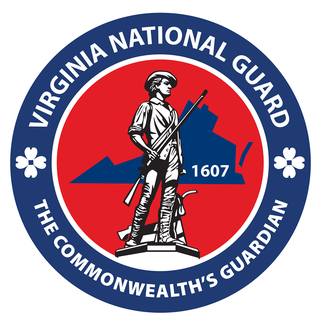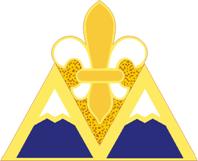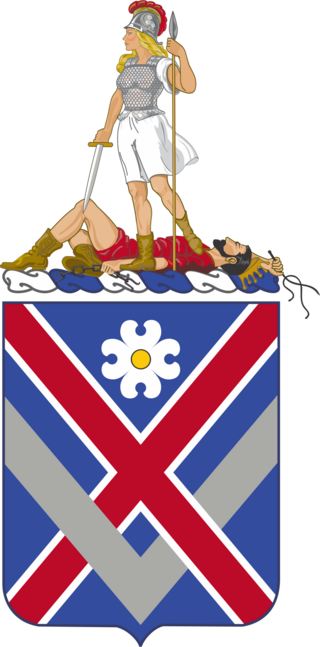
The 29th Infantry Division, also known as the "Blue and Gray Division", is an infantry division of the United States Army based at Fort Belvoir in Fairfax County, Virginia. The division is currently a formation of the Army National Guard and includes units from Virginia, Maryland, Kentucky, North Carolina, South Carolina, and West Virginia.

The Virginia Defense Force (VDF) is the official state defense force of Virginia, one of the three components of Virginia's state military along with the Virginia National Guard which includes the Virginia Army National Guard, the Virginia Air National Guard, and the unorganized militia. As of 2023, the VDF has approximately 275 personnel. The VDF is the descendant of the Virginia State Guard, the Virginia Regiment, and ultimately the Colonial Virginia militia of the Virginia Colony.

The Massachusetts National Guard is the National Guard component for the Commonwealth of Massachusetts. Founded as the Massachusetts Bay Colonial Militia on December 13, 1636, it contains the oldest units in the United States Army. What is today's Massachusetts National Guard evolved through many different forms. Originally founded as a defensive militia for Puritan colonists in the Massachusetts Bay Colony, the militia evolved into a highly organized and armed fighting force. The Massachusetts militia served as a central organ of the New England revolutionary fighting force during the early American Revolution and a major component in the Continental Army under George Washington.

The Virginia National Guard consists of the Virginia Army National Guard and the Virginia Air National Guard. It is part of the Government of Virginia though the National Guard across the United States is mostly funded by the federal government. The National Guard is the only United States military force empowered to function in a state status. Those functions range from limited actions during non-emergency situations to full scale law enforcement of martial law when local law enforcement officials can no longer maintain civil control. The National Guard may be called into federal service in response to a call by the President or Congress, in accordance with Title 10 of the United States Code.

The West Virginia National Guard is a part of the West Virginia Department of Military Affairs and Public Safety. It comprises the West Virginia Army National Guard and the West Virginia Air National Guard. Unlike some states, West Virginia does not maintain a state defense force, nor is there a naval component to the state's military forces.

The New York Army National Guard is a component of the New York National Guard and the Army National Guard. Nationwide, the Army National Guard comprises approximately one half of the United States Army's available combat forces and approximately one third of its support organization. National coordination of various state National Guard units are maintained through the National Guard Bureau.

The Florida Army National Guard is Florida's component of the United States Army and the United States National Guard. In the United States, the Army National Guard comprises approximately one half of the federal army's available combat forces and approximately one third of its support organization. Federal coordination of various state National Guard units are maintained through the National Guard Bureau. The Florida Army National Guard was composed of approximately 10,000 soldiers. The main state training grounds is Camp Blanding.

The Pennsylvania Army National Guard, abbreviated PAARNG, is part of the United States Army National Guard and is based in the U.S. Commonwealth of Pennsylvania. Together with the Pennsylvania Air National Guard, it is directed by the Pennsylvania Department of Military and Veterans Affairs. The PAARNG maintains 124 armories and is present in 87 communities across the Commonwealth.

The Alabama Army National Guard is a component of the United States Army and the United States National Guard. National coordination of various state National Guard units are maintained through the National Guard Bureau.

The Georgia Army National Guard is the Army National Guard component of the Georgia National Guard, administratively part of the Georgia Department of Defense. It consists of more than 11,100 citizen-soldiers training in more than 79 hometown armories and regional facilities across the state. Georgia’s Army Guard is the sixth largest in the nation and includes combat, combat support and combat service support units.

The Idaho Army National Guard is a component of the United States Army and the United States National Guard. Nationwide, the Army National Guard comprises approximately one half of the US Army's available combat forces and approximately one third of its support organization. National coordination of various state National Guard units are maintained through the National Guard Bureau.

The Montana Army National Guard is a component of the United States Army and the United States National Guard. Nationwide, the Army National Guard comprises approximately one half of the US Army's available combat forces and approximately one third of its support organization. National coordination of various state National Guard units are maintained through the National Guard Bureau.

The 116th Infantry Brigade Combat Team is an infantry brigade combat team currently assigned to the Virginia Army National Guard, formerly known as the 1st Brigade, 29th Infantry Division; it is the largest command of the Virginia Army National Guard with an authorized strength of 3,400. The brigade is headquartered in Staunton, Virginia, at the Thomas Howie Memorial Armory, and is nicknamed the Stonewall Brigade in honor of its association with the 116th Infantry Regiment, tracing its lineage back to elements of an American Civil War Confederate brigade of the same name led by General Stonewall Jackson.

The 116th Cavalry Brigade Combat Team is the largest formation of the Idaho Army National Guard. It is headquartered at Gowen Field, Boise, Idaho. It has been reorganized into an Armored Brigade Combat Team (ABCT) but remains the only unit to be designated a "Cavalry Brigade Combat Team" by special appointment of the US Army. The 116th Cavalry Brigade Combat Team has units located throughout Idaho, Montana, Oregon, and Nevada. It was reorganized into a heavy armor brigade in 1989. Often referred to as the Snake River Brigade and formerly known as the 116th Armored Cavalry Regiment, the unit includes about 3,000 citizen-soldiers from Idaho.
Twenty-four current units of the Army National Guard perpetuate the lineages of militia units mustered into federal service during the War of 1812. Militia units from nine states that were part of the Union by the end of the War of 1812, plus the District of Columbia, are the predecessors of eighteen units that currently exist in the Army National Guard. Two of the four units derived from Virginia militias are in the West Virginia National Guard; at the time of the War of 1812, West Virginia was still part of Virginia. Only two current units, the 155th Infantry, a component of the Mississippi National Guard derived from militia units organized in the Mississippi Territory and the 130th Infantry, a component of the Illinois National Guard derived from militia units formed in the Illinois Territory, are from states or territories west of the Appalachians. Unfortunately, no militia units from the states of Kentucky, Louisiana, Ohio or Tennessee, or from the Indiana, Michigan, Missouri or Louisiana Territories, where militia units played a major role in the fighting, have survived as units in the modern Army National Guard.

The 276th Engineer Battalion is an engineer battalion of the Virginia Army National Guard. Headquartered in Petersburg, Virginia, it is one of several Army National Guard units with campaign credit for the War of 1812.

The 103rd Field Artillery Regiment is a regiment of the United States Army. The only currently existing component is the 1st Battalion, 103rd Field Artillery Regiment, a unit of the Rhode Island National Guard. The regiment was originally constituted in 1917, but it descends from predecessor units dating back to 1801.

The 183rd Cavalry Regiment is a cavalry regiment of the United States Army, represented in the Virginia Army National Guard by 2nd Squadron, 183rd Cavalry (2-183). The squadron is the reconnaissance, surveillance, and target acquisition squadron of the 116th Infantry Brigade Combat Team, part of the 29th Infantry Division.

The 229th Brigade Engineer Battalion is an Engineer Battalion in the Virginia Army National Guard, part of the 29th Infantry Division's 116th Infantry Brigade Combat Team. First formed under the designation in 1985, it became the 116th Brigade Special Troops Battalion in 2005. It was renamed the 229th Brigade Engineer Battalion once again in 2016.

The 429th Brigade Support Battalion is a combat service support battalion of the United States Army and the Virginia National Guard. It is part of the 116th Infantry Brigade Combat Team, Virginia Army National Guard.





















